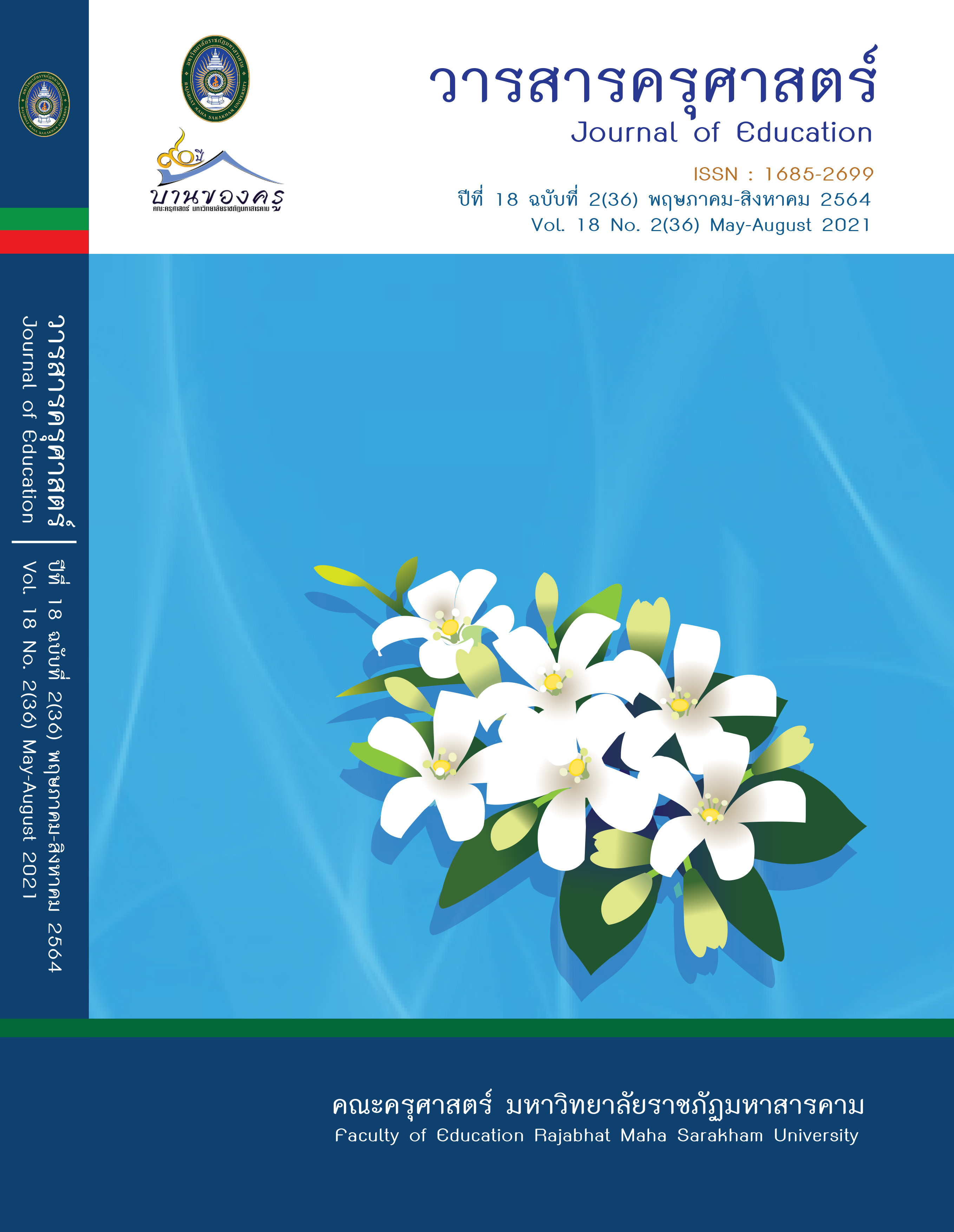A Study of Science Learning Achievement, Creative Thinking and Satisfaction of 7thGrade Students Through STEM Learning Activity Packageson Soilless Culture
Main Article Content
Abstract
The objectives of this studywere as follows: (1) to compare the science learning achievementof the 7th grade students before and after learning by using STEM learning activity; (2) tocompare the science learning achievement with the criteria of 60%; (3) to study the students’ creative thinking; and (4) to studysatisfaction toward learning with a STEM learning activity package on soilless culture. The samples of the researchwere 32 Seventh Grade students in NikhomSongklorVittaya School, who studied in the second semester of the 2020academic year. The sample was obtained with the purposive sampling technique. The research design was a One-Group Pretest-Posttest Design. The participants were studied using a STEM learning activity package on soillessculture. The research instruments were: (1) a STEM learning activity package; (2) lesson plans; (3) a science learningachievement test; (4) a creative thinking test, and (5) a satisfaction survey form. A t-test for dependent samples wasused to analyze the data. The research findings were as follows: (1) the scores on science learning achievement testafter students learning with STEM learning activity package higher than before and with a learning significance levelof .01 and higher than the criteria set at 60% not significance; (2) creative thinking in science was at a very good level;and (3) the satisfaction of toward learning with STEM learning activity package was at a good level.
Article Details
ข้อกำหนดเบื้องต้นที่ผู้นิพนธ์(ผู้ส่งบทความ) ควรทราบ
1. ผู้นิพนธ์ที่ประสงค์จะลงตีพิมพ์บทความกับวารสาร ตั้งแต่เดือนมกราคม 2563 เป็นต้นไป ให้ใช้รูปแบบใหม่ (Template 2563) โดยสามารถดูตัวอย่างได้ที่เมนู GUIDELINES
2. จะตีพิมพ์และเผยแพร่ได้ ต้องผ่านการประเมินจากผู้ทรงคุณวุฒิ (Peer Review)
3. การประเมินบทความโดยผู้ทรงคุณวุฒิ (Peer Review) เป็นแบบ Double Blind
4. การอ้างอิงบทความใช้หลักเกณฑ์ APA (American Psychological Association) คลิก
5. บทความถูกปฏิเสธการตีพิมพ์ ไม่ผ่านการประเมิน ผู้นิพนธ์ขอยกเลิกเองหรือชำระเงินก่อนได้รับการอนุมัติ ทางวารสารไม่มีนโยบายการคืนเงิน
References
ขจรเดช บุตรพรม. (2560). เปิดเล่ม สสวท. “สะเต็มศึกษา”. นิตยสาร สสวท, 42(186), 1.
ชวลิต โพธิ์นคร. (2560, 31 มีนาคม). การศึกษาไทยในยุคไทยแลนด์ 4.0. Mahidol library KM. http://km.li.mahidol.ac.th/thai-studies-in-thailand-4-0/.
ชาญณรงค์ พรรุ่งโรจน์. (2560). ความคิดสร้างสรรค์ (Creative Thinking).สำนักพิมพ์แห่งจุฬาลงกรณ์มหาวิทยาลัย.
นัสรินทร์บือซา. (2558). ผลการจัดการเรียนรู้ตามแนวคิดสะเต็มศึกษา (STEM Education) ที่มีต่อผลสัมฤทธิ์ทางการเรียนชีววิทยา ความสามารถในการแก้ปัญหาและความพึงพอใจต่อการจัดการเรียนรู้ของนักเรียนชั้น มัธยมศึกษาปีที่ 5 [วิทยานิพนธ์ปริญญามหาบัณฑิต ไม่ได้ตีพิมพ์].มหาวิทยาลัยสงขลานครินทร์
ภัสสร ติดมา. (2558). การจัดการเรียนรู้ตามแนวทาง STEM Education เรื่องระบบของร่างกายมนุษย์ เพื่อส่งเสริมความคิดสร้างสรรค์ สำหรับนักเรียนชั้นมัธยมศึกษาปีที่ 2[วิทยานิพนธ์ปริญญามหาบัณฑิต ไม่ได้ ตีพิมพ์]. มหาวิทยาลัยนเรศวร.
รักษพล ธนานุวงศ์. (2559). เรียนรู้สภาวะโลกร้อนด้วย STEM Education แบบบูรณาการ. นิตยสาร สสวท,41(182), 15-20.
ศิริรัตน์ ราชยอด. (2558). ผลของการใช้ชุดกิจกรรมวิทยาศาสตร์แบบบูรณาการ เรื่อง ระบบร่างกายมนุษย์ สำหรับนักเรียนชั้นมัธยมศึกษาปีที่ 2[ปริญญานิพนธ์ปริญญามหาบัณฑิต ไม่ได้ตีพิมพ์]. มหาวิทยาลัยศรีนครินทร วิโรฒ.
สถาบันส่งเสริมการสอนวิทยาศาสตร์และเทคโนโลยี. (2559, 19 เมษายน). สรุปผลการวิจัย PISA 2015.PISA.Thailand. http://pisathailand.ipst.ac.th/pisa/reports/pisa2015summaryreport
อภิสิทธ์ ธงไชย. (2560). ความคิดสร้างสรรค์กับนักประดิษฐ์. นิตยสาร สสวท, 42(186), 1.
อารี พันธ์มณี. (2557). ฝึกให้คิดเป็น คิดให้สร้างสรรค์. สำนักพิมพ์แห่งจุฬาลงกรณ์มหาวิทยาลัย.


